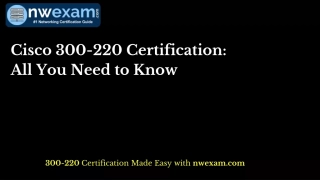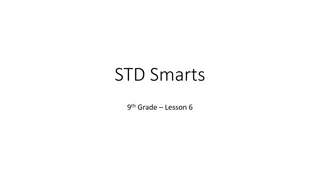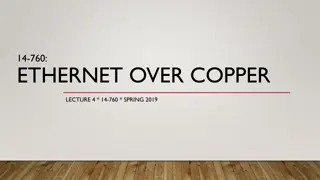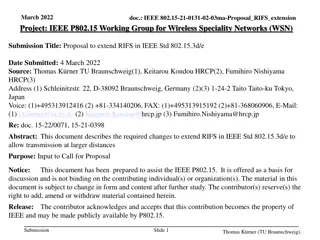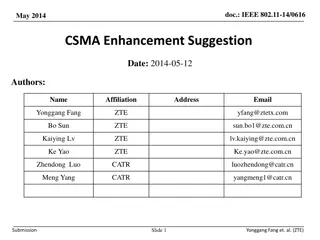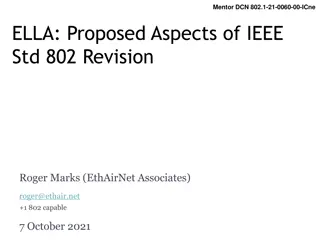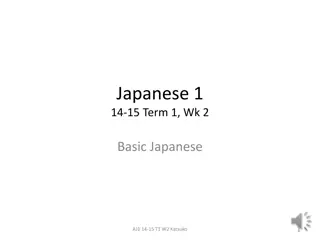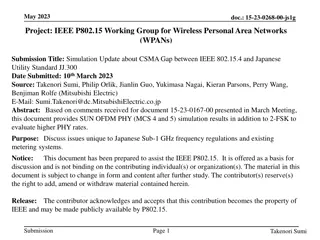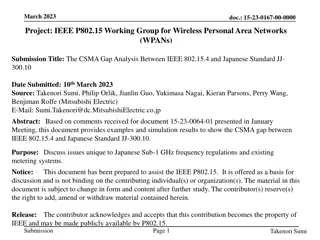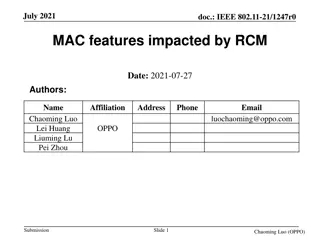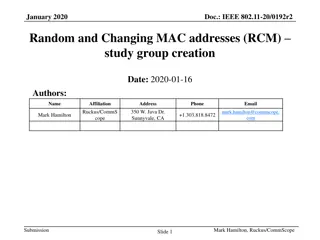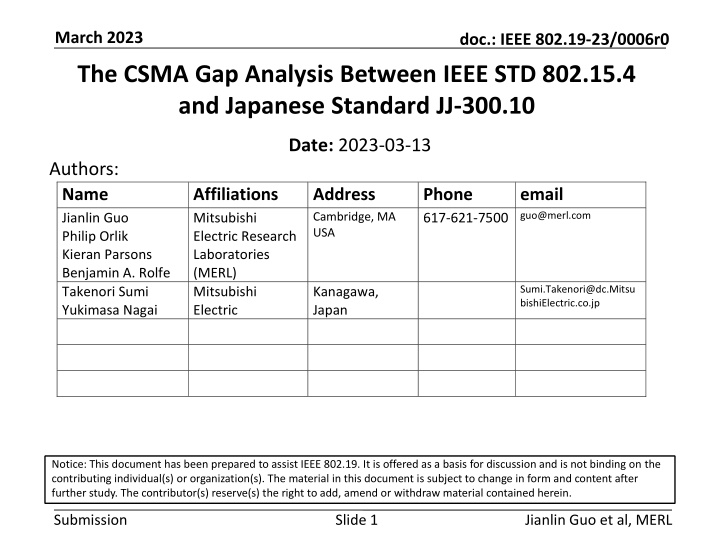
CSMA Gap Analysis Between IEEE STD 802.15.4 and Japanese Standard JJ-300.10
This document delves into the communication gap analysis between IEEE STD 802.15.4 and the Japanese Standard JJ-300.10, focusing on unique challenges posed by Japanese Sub-1 GHz frequency regulations and existing metering systems. It aims to address concerns regarding the compatibility of current 802.15.4 standards with the metering requirements in Japan's congested Sub-1 GHz bands. The background of Japanese utility systems, evolving smart metering infrastructure demands, and ongoing IEEE standardization efforts for the Sub-1 GHz band are also discussed.
Download Presentation

Please find below an Image/Link to download the presentation.
The content on the website is provided AS IS for your information and personal use only. It may not be sold, licensed, or shared on other websites without obtaining consent from the author. If you encounter any issues during the download, it is possible that the publisher has removed the file from their server.
You are allowed to download the files provided on this website for personal or commercial use, subject to the condition that they are used lawfully. All files are the property of their respective owners.
The content on the website is provided AS IS for your information and personal use only. It may not be sold, licensed, or shared on other websites without obtaining consent from the author.
E N D
Presentation Transcript
March 2023 doc.: IEEE 802.19-23/0006r0 The CSMA Gap Analysis Between IEEE STD 802.15.4 and Japanese Standard JJ-300.10 Date: 2023-03-13 Authors: Name Jianlin Guo Philip Orlik Kieran Parsons Benjamin A. Rolfe Takenori Sumi Yukimasa Nagai Affiliations Mitsubishi Electric Research Laboratories (MERL) Mitsubishi Electric Address Cambridge, MA USA Phone 617-621-7500 guo@merl.com email Sumi.Takenori@dc.Mitsu bishiElectric.co.jp Kanagawa, Japan Notice: This document has been prepared to assist IEEE 802.19. It is offered as a basis for discussion and is not binding on the contributing individual(s) or organization(s). The material in this document is subject to change in form and content after further study. The contributor(s) reserve(s) the right to add, amend or withdraw material contained herein. Submission Slide 1 Jianlin Guo et al, MERL
March 2023 doc.: IEEE 802.19-23/0006r0 Abstract This document describes the CSMA gap (or difference) between IEEE STD 802.15.4 and Japanese Standard JJ-300.10 It discusses issues unique to Japanese Sub-1 GHz frequency regulations and existing metering systems Purpose of this document is to discuss concerns about the ability of existing 802.15.4 standards to support the expected metering application needs in Japan s Sub-1 GHz frequency bands and congested situation Submission Slide 2 Jianlin Guo et al, MERL
March 2023 doc.: IEEE 802.19-23/0006r0 Background of Japanese Utility Systems Japanese utility systems operate in Sub-1 GHz frequency band More specifically in 920 MHz band, and limited frequency bandwidth Japanese electric utilities are now updating their 1st generation smart metering infrastructure New requirements are coming to light Meter reporting duty cycles are expected to decrease from 30 minutes to 5 minutes At least a 6x increase in throughput will be needed, latency reduced by factor of 6 as well Likely need for multi-metering functionality on single radio Over-the-air (OTA) firmware/software capability are needed This means more data traffic and more channel access Submission Slide 3 Jianlin Guo et al, MERL
March 2023 doc.: IEEE 802.19-23/0006r0 Background of IEEE 802 Sub-1 GHz Band Standardization Sub-1 GHz standard development continue to grow 802.15.4g, 802.11ah, 802.19.3, 802.11 WG is working on the enhancement of Sub-1 GHz band operations 802.11ah was developed based on 802.11ac Newer PHYs have been introduced since, e.g., 1024 QAM was added in IEEE 802.11ax Newer PHYs have introduced functionality that would be beneficial to Sub 1 GHz operation, e.g., to improve throughput Again, this means more data traffic and more channel access Submission Slide 4 Jianlin Guo et al, MERL
March 2023 doc.: IEEE 802.19-23/0006r0 Issues in Japanese Utility Systems Japanese utility systems support ECHONET protocols, which are based on a Japanese communication standard JJ-300.10 CSMA/CA in JJ-300.10 is different from CSMA/CA in 802.15.4 In Japan, Sub-1 GHz spectrum is scarce At most 2.9 MHz* is optimized for metering applications using CSMA leads to congestion and interference issues as more devices with different protocols exists in narrower bandwidth See IEEE802.19.3 for issues arising from limited spectrum availability and protocol differences among 802.15.4g and 802.11ah For 802.15.4 to better support utility applications in Japan, more enhancements are needed Consider the support for JJ-300.10 Coexistence with more aggressive channel access protocols such as 802.11 In addition, 802.15.4 needs to take advantage of devices without power constraints such as grid powered smart meters * See pg. 113: 920MHz-BAND TELEMETER, TELECONTROL AND DATA TRANSMISSION RADIO EQUIPMENT ARIB STANDARD Submission Slide 5 Jianlin Guo et al, MERL
March 2023 doc.: IEEE 802.19-23/0006r0 CSMA/CA in JJ-300.10 Includes Number of Retries Key differences reside inside of this box Distinguishes unicast and multicast Submission Slide 6 Jianlin Guo et al, MERL
March 2023 CSMA Differences Between JJ-300.10 and 802.15.4 doc.: IEEE 802.19-23/0006r0 802.15.4-2011 JJ-300.10 CSMA/CA differences 1. Consider non-slotted scenario 2. Consider data frame 3. Incorporate number of retries (NR) 4. Distinguish unicast and multicast 5. Wait for LIFS time before backoff starts 6. Backoff suspension Differences 1-2 make JJ-300.10 a special case of 802.15.4 Differences 3-4 provide more details However, differences 5-6 make JJ-300.10 channel access different from 802.15.4 Submission Slide 7 Jianlin Guo et al, MERL
March 2023 CSMA Differences Between JJ-300.10 and 802.15.4 doc.: IEEE 802.19-23/0006r0 JJ-300.10 backoff operation specified in Figure 5-17 Wait Backoff suspension Expected impact of wait Increase latency due to the delayed backoff start Expected impact of backoff suspension Improve packet delivery reliability due to less frame drop caused by backoff failure Increase latency due to longer backoff time Reduce number of backoffs JJ-300.10 performs re-backoff only if busy channel starts in CCA period 802.15.4 performs re-backoff if channel is busy in CCA period Submission Slide 8 Jianlin Guo et al, MERL
March 2023 Re-Backoff Difference Between JJ-300.10 and 802.15.4 doc.: IEEE 802.19-23/0006r0 Scenario-1:Other TX starts before CCA TX Other devices Time TX request CCA Backoff Re-Backoff 802.15.4 backoff Time TX request LIFS Backoff Suspension LIFS TX Backoff CCA JJ-300.10 backoff Time Scenario-2: Other TX starts during CCA Time TX Other devices Time TX request Slide 9 Re-Backoff CCA Backoff 802.15.4 backoff Time TX request LIFS CCA Re-Backoff Backoff JJ-300.10 backoff Time Submission Jianlin Guo et al, MERL
March 2023 doc.: IEEE 802.19-23/0006r0 Simulation Parameters Parameter Value Note Nodes 10 100 Offered load(Network)[kbps] 10, 20, 30 , 40, 50 Packet size[Byte] 100 MAC payload MAC parameters (JJ 300.10 v2.2, Table 5-28, 5-29) LIFS[us] 1000 phyCCADuration[us] 130 aTurnaroundTime[us] 1000 aUnitBackoffPeriod[us] 1130 Rx-to-Tx Turnaround time[us] 300 300 us or more, 1000 us or less Tx-to-Rx Turnaround time[us] 300 Less than 300 us macMaxBE 8 macMinBE 8 macMaxCsmaBackoffs 4 macMaxFrameRetries 3 Submission Slide 10 Jianlin Guo et al, MERL
March 2023 doc.: IEEE 802.19-23/0006r0 Illustration of 20 Node Deployment 100 80 60 40 20 y[m] 0 -20 -40 -60 -80 -100 -100-80 -60 -40 -20 0 20 40 60 80 100 x[m] PANC was placed at the center of a 100 m circle. Each node was placed using the sunflower algorithm. Each node sends packets to PANC. Submission Slide 11 Jianlin Guo et al, MERL
March 2023 doc.: IEEE 802.19-23/0006r0 Simulation Results (Packet delivery rate) JJ-300.10 Offered load[kbps] 10 20 30 40 0.999679 0.999679 0.990308 0.759237 0.606747 0.999679 0.999599 0.998691 0.95008 0.773403 0.999759 0.999719 0.999679 0.999398 0.931797 1 0.999639 0.999732 0.999297 0.987357 0.999839 0.999839 0.999839 0.999257 0.995454 0.999759 0.99984 0.999759 0.999338 0.997641 0.999839 0.99992 0.999679 0.999398 0.994458 1 0.999679 0.999625 0.999478 0.99698 0.99992 0.999679 0.999786 0.999619 0.99793 0.999759 0.9998 0.999733 0.999419 0.997756 Standard CSMA/CA Offered load[kbps] 10 0.999759 0.99984 0.999519 0.999839 0.999679 0.999599 0.999759 Nodes 20 30 40 50 Nodes 50 10 20 30 40 50 60 70 80 90 100 0.998474 0.998477 0.998676 0.998474 0.998273 0.998355 0.998755 0.998675 0.998195 0.998597 0.965114 0.989579 0.990746 0.990575 0.98929 0.990424 0.98921 0.989024 0.989568 0.98899 0.729096 0.955691 0.958252 0.962129 0.959699 0.957193 0.959076 0.959516 0.957172 0.959619 0.579261 0.804072 0.880011 0.902296 0.89351 0.893793 0.89688 0.896718 0.897407 0.898301 10 20 30 40 50 60 70 80 90 1 0.999759 0.999679 100 Difference (JJ-300.10 - Standard) Offered load[kbps] 10 -8E-05 -0.00016 0.00024 0.000161 0.00016 0.00016 8E-05 Nodes 20 30 40 50 10 20 30 40 50 60 70 80 90 0.001205 0.001122 0.001043 0.001165 0.001566 0.001485 0.001165 0.001004 0.001484 0.001203 0.025194 0.009112 0.008933 0.009157 0.010549 0.009335 0.010469 0.010601 0.010218 0.010743 (1) 0.030141 -0.00561 0.041146 0.037168 0.039558 0.042145 0.040322 0.039962 0.042447 0.0398 (2) 0.027486 -0.03067 0.051786 0.085061 0.101944 0.103848 0.097578 0.100262 0.100523 0.099455 (3) 0 0.000161 8E-05 100 (1) Approximately 1% improvement on packet delivery rate when offered load is 30 kbps and 10 - 100 nodes. (2) Approximately 4% improvement on packet delivery rate when offered load is 40 kbps and 40 100 nodes. (3) Approximately 10% improvement on packet rate when offered load is 50 kbps and 40 -100 nodes. Submission Slide 12 Jianlin Guo et al, MERL
March 2023 doc.: IEEE 802.19-23/0006r0 Packet Delivery Rate Curve for 50 kbps Offered Load Result summary For light traffic load, JJ-300.10 and 802.15.4g have similar performance For heavier traffic load, JJ-300.10 outperforms 802.15.4g, e.g., 10% improvement for 50 kbps offered load When network size (number of nodes) is smaller, each node has higher offered load and so more packets are dropped due to protocol efficiency for both JJ-300.10 and 802.15.4g Submission Slide 13 Jianlin Guo et al, MERL
March 2023 Consideration of IEEE 802.15.4 CSMA/CA on Devices without power constraint doc.: IEEE 802.19-23/0006r0 Power consumption has been a key consideration in 802.15.4 protocol design Battery power devices dominate 802.15.4 market However, new market sectors are emerging, where power supply is not a constraint E.g., grid powered smart meters Such devices are typically deployed outdoor and may coexist with other systems such as 802.11, LoRa, SigFox, These coexisting devices are either use aggressive CSMA or Aloha Therefore, they can significantly degrade performance of 802.15.4 based systems (see 802.19.3) Therefore, when power supply is not an issue, 802.15.4 may upgrade its CSMA/CA mechanism to increase channel access opportunity Especially while coexisting with other systems and the poor performance present Submission Slide 14 Jianlin Guo et al, MERL
March 2023 Consideration of IEEE 802.15.4 CSMA/CA on Devices without power constraint doc.: IEEE 802.19-23/0006r0 Perform CCA during backoff can increase channel access probability TX TX TX TX TX Other devices Time This time period is an opportunity for IEEE 802.15.4 device to transmit 802.15.4 device would TX here Channel Idle Had 802.15.4 device continue CCA Transmission request CCA TX Backoff CCA Backoff Backoff CCA CCA CCA Backoff 802.15.4 device Time Channel Busy Channel Busy Channel Busy Channel Busy 802.15.4 NB 0 1 2 M M+1 M = macMaxCSMABackoffs Submission Slide 15 Jianlin Guo et al, MERL
March 2023 doc.: IEEE 802.19-23/0006r0 Summary This document describes the CSMA gap (or difference) between IEEE STD 802.15.4 and Japanese Standard JJ-300.10. It provides simulations for the gap analysize. It aims to discuss concerns about the ability of existing 802.15.4 standards to support the expected metering application needs in Japan s Sub-1 GHz frequency bands and congested situation. Comments and feedback from 802.19 WG are welcome! Submission Slide 16 Jianlin Guo et al, MERL

